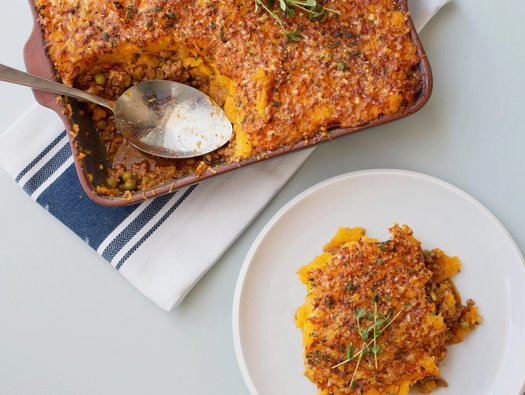Shepherd’s pie with swede and carrot mash

This hearty dish is a great source of protein with plenty of tasty vegetables yet is low in salt, potassium and phosphate. A great post dialysis meal.

This hearty dish is a great source of protein with plenty of tasty vegetables yet is low in salt, potassium and phosphate. A great post dialysis meal.
1 tablespoon vegetable oil
1 large onion, diced
2 celery sticks, diced
2 garlic cloves, crushed
1 bay leaf
2 teaspoons fresh thyme, chopped
450-475g lean lamb mince
Beef stock cube, low salt
150ml boiling water
300g passata
2 teaspoons wholegrain mustard
1 tablespoon Worcestershire sauce
1 small swede (approximately 450g), peeled and diced
375g carrots, peeled and sliced
150g frozen peas
25g unsalted butter
25g parmesan (optional)
Preheat the oven to 190ᵒC / 170ᵒC fan / gas mark 5. Heat a large non-stick pan and add the oil. Once the oil is hot, add the onion, celery, garlic, bay leaf and thyme and cook for 6 to 8 minutes until soft.
Add the lamb mince and cook for 5 minutes or until browned. Make up the stock using 150ml boiling water. Add the stock, passata, mustard and Worcestershire sauce. Bring to the boil, then reduce the heat and simmer for 25 minutes.
While the filling is cooking, prepare the swede and carrots then add them to a large saucepan of water and bring to the boil. Reduce the heat and simmer for 20 minutes or until soft.
Drain, then return to the pan and turn off the heat. Mash the swede and carrot with the butter, season with black pepper and set aside.
Stir the peas into the filling, then spoon the mixture into a baking dish. Cover evenly with the swede and carrot topping, then grate the parmesan over the top.
Bake for 20 minutes or until the topping is golden. Remove from the oven and leave to cool for 5 minutes before serving.
The carbohydrate in this dish comes mainly from the swede, carrots and passata. The carbohydrate value of this dish has been provided for those who have been trained in insulin adjustment.
Despite the use of some high potassium ingredients, such as passata, this recipe is low in potassium, when following the quantities and serving sizes shown. Using a swede and carrot topping, rather than potato, helps to lower the amount of potassium in this dish. Therefore, this recipe is suitable for those advised to lower potassium in their diet.
This recipe is also low in phosphate, however it does contain some phosphate, mainly provided by the lamb mince, therefore if you have been prescribed a phosphate binder you should take as directed.
This recipe provides a source of protein which, makes it suitable for those receiving dialysis. If you have been advised to reduce your protein intake, use half the quantity of lamb and replace with a 400g tin of drained tinned lentils, such as green lentils or opt for the vegetarian alternative such as Quorn.
Use a gluten-free stock cube to make it suitable for a gluten free diet.
Omit the Worcestershire sauce and use a vegetarian mince alternative, or try using tinned lentils, in water and without added salt.
The low salt beef stock and Worcestershire sauce is the main source of salt in this dish. Whilst it adds flavour, by missing out the Worcestershire sauce you can reduce the salt content further and instead add more Italian herbs.
Try the vegetarian option using lentils to reduce the cost or use leftover lamb from your Sunday roast. A switch to lean beef, turkey or chicken would create a very flavoursome alternative as well.
With any leftover shepherd’s pie, allow to cool then refrigerate and eat within two days. If freezing, place in a sealed container. When reheating, ensure that the food has been defrosted thoroughly and that it is piping hot before serving.
By giving us your email address, you're giving us permission to send you the latest news from Kidney Care UK. Further information about how we protect and use your personal data is available in our Privacy policy. If you would like to change the way we communicate with you at any time please email [email protected]. You can unsubscribe at any time by using the link at the bottom of every email we send.